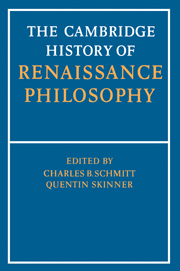Book contents
- Frontmatter
- Introduction
- PART 1 THE INTELLECTUAL CONTEXT
- 1 The conditions of enquiry: Manuscripts
- 2 The conditions of enquiry: Printing and censorship
- 3 The Renaissance concept of philosophy
- 4 Translation, terminology and style in philosophical discourse
- 5 Humanism
- PART 2 PHILOSOPHY AND ITS PARTS
- PART 3 SUPPLEMENTARY MATERIAL
- Biobibliographies
- Bibliography
- Index nominun
- Index rerum
- References
1 - The conditions of enquiry: Manuscripts
from PART 1 - THE INTELLECTUAL CONTEXT
Published online by Cambridge University Press: 28 March 2008
- Frontmatter
- Introduction
- PART 1 THE INTELLECTUAL CONTEXT
- 1 The conditions of enquiry: Manuscripts
- 2 The conditions of enquiry: Printing and censorship
- 3 The Renaissance concept of philosophy
- 4 Translation, terminology and style in philosophical discourse
- 5 Humanism
- PART 2 PHILOSOPHY AND ITS PARTS
- PART 3 SUPPLEMENTARY MATERIAL
- Biobibliographies
- Bibliography
- Index nominun
- Index rerum
- References
Summary
Manuscripts proved to be an effective vehicle for the expression and dissemination of ideas throughout the later Middle Ages and the Renaissance. Even though the invention and advance of printing narrowed their scope, printing never rendered manuscripts completely irrelevant. Numerous treatises either did not require to be or could not be printed or were published only long after their composition. Such texts had to be read in manuscript. Philosophical manuscripts in particular retained their value, both for the continuation of traditional philosophical schools and procedures and for the exposition and communication of new ideas. The manuscript culture which had developed in the Middle Ages continued to serve a variety of readers throughout the sixteenth century.
A comprehensive history of the role played by manuscripts in Renaissance thought is yet to be written. Renaissance philosophical manuscripts as a topic of scholarly investigation have been ignored for a variety of reasons. On the one hand, they have fallen victim to the medievalists' concentration on the various scholastic traditions in the Middle Ages to the exclusion of their (and other philosophical schools') later manifestations, while on the other hand the Renaissance humanists' hostility towards scholasticism and Aristotelian logic and metaphysics have caused historians to slight many branches of Renaissance philosophy. We lack large-scale studies delineating the diffusion of philosophical manuscripts and their use in the Renaissance on which to base large-scale generalisations, even for such fundamental writers as Aristotle and Thomas Aquinas. Here only a brief sketch can be offered by way of providing certain general organising themes and proposing a coherent explanation for the continued importance of manuscripts as a philosophical medium throughout the Renaissance.
- Type
- Chapter
- Information
- The Cambridge History of Renaissance Philosophy , pp. 7 - 24Publisher: Cambridge University PressPrint publication year: 1988



